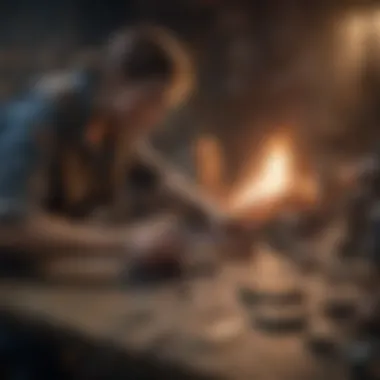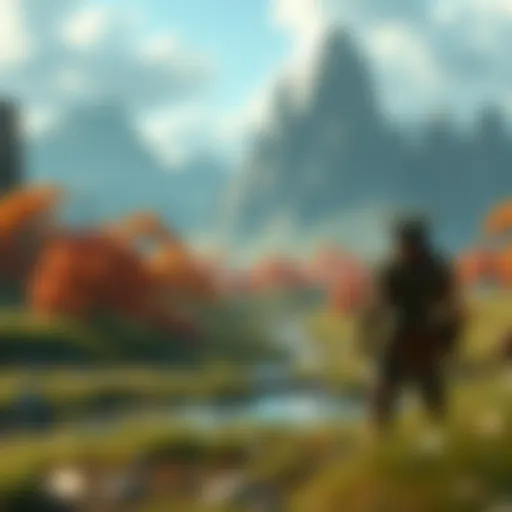Exploring Open World Zombie Survival Games: A Deep Dive


Intro
The world of open world survival zombie games has become a captivating genre within the gaming landscape, drawing players into its intricate narrative webs and vast, post-apocalyptic environments. With a diverse array of titles catering to different tastes and play styles, this genre has evolved significantly over the years. From the early days of simple mechanics and limited graphical fidelity to the modern offerings that boast complex gameplay mechanics and immersive storytelling, the evolution of this genre is nothing short of remarkable.
In this exploration, we'll journey through various facets that contribute to the enduring popularity of open world survival zombie games. By delving into unique gameplay characteristics, artistic designs, and the rich narratives that define these games, we can uncover why they resonate with so many people. In addition, we’ll shine a spotlight on both well-known titles and lesser-known indie gems, providing a comprehensive understanding of the impact and cultural significance of these games in the broader spectrum of gaming culture.
As we traverse through this terrain, we aim to not only highlight key points of interest but also immerse ourselves in the underlying themes that continuously engage players, driving an ever-expanding community of enthusiasts who crave immersive experiences in zombie-infested worlds.
Prelims to Open World Survival Zombie Games
The world of video gaming has long been shaped by diverse genres, but few have carved as intense a niche as open world survival zombie games. This genre doesn’t just offer countless hours of entertainment; it provides a gritty playground for exploring human resilience, resource management, and narrative depth against a backdrop of chaos. Understanding the dynamics of these games is crucial for both gamers and developers alike.
In a landscape littered with survival titles, pinpointing the essence of what makes these zombie games tick is vital. The interplay between survival mechanics and expansive, immersive worlds not only engages players but also mirrors their real-life decision-making processes under pressure. Insights gained from dissecting this genre can illuminate broader trends in game design and player interaction, benefiting creators and players.
Defining the Genre
Open world survival zombie games, quite simply, create a vast sandbox filled with the undead and a plethora of survival challenges. The objective is straightforward yet multifaceted—survive. This involves gathering resources, managing health, and oftentimes, making moral choices that can have dire consequences. Players weave through environments that are often rich with lore and visual storytelling, crafting their narrative as they navigate through the chaos.
Characterized by exploration, crafting, and combat, these games forgo linear storytelling in favor of open-ended gameplay, allowing players the freedom to forge their own paths. Their success hinges not only on survival but also on the thrill of discovery and the fear of the known and unknown alike—perhaps the ultimate draws in engaging and retaining an audience.
Historical Context
The genre's roots can be traced back to early survival titles, but it wasn't until the mid-2000s that the zombie apocalypse narrative gained mainstream traction. The success of games like "DayZ" marked a turning point, showcasing how players could interact with a shared world filled with other survivors, not just zombies. This laid the groundwork for future titles such as "7 Days to Die" and "Rust," which further fleshed out the mechanics of survival while integrating permadeath, crafting, and base building. The evolution from these early iterations has paved the way for more intricate systems and storytelling approaches that place an emphasis on player choice and interaction.
Cultural Significance
The cultural resonance of open world survival zombie games goes beyond mere entertainment value. They act as a mirror, reflecting our societal anxieties about existential threats—be they environmental, political, or viral. The zombie, as a metaphor for societal decay and fear, strikes a chord in the psyche of players. This amalgamation of horror and survival speaks to fundamental human instincts, tapping into our collective fears and thrilling our imaginations.
Moreover, these games foster a sense of community, with players often collaborating or competing in their pursuit of survival. The stories born from these interactions blur the line between player and character, inviting deeper engagement and discussion among fans. Notably, platforms like Reddit and Facebook have seen vibrant discussions and fan contributions, amplifying the cultural footprint of these titles and ensuring their place in our shared gaming history.
"The zombie genre serves not merely to entertain but to challenge and provoke thought about our own humanity in the face of disaster."
As we explore the vast terrain of open world survival zombie games, we will delve into the mechanics that underpin gameplay, the narratives that enrich player experiences, and the communities that thrive within these virtual worlds.
Core Gameplay Mechanics
In the world of open world survival zombie games, core gameplay mechanics serve as the backbone, delineating what makes a game not just immersive, but genuinely captivating. These mechanics are the intricate gears that keep players engaged, creating a unique blend of tension and satisfaction. The ability to seamlessly navigate survival elements, crafting and resource management, and combat strategies can make or break the gaming experience.
Survival Elements
Survival is, as the name suggests, at the heart of these games. The mechanics surrounding survival often require players to scavenge for food, water, and shelter while also ensuring they don’t become a midnight snack for lurking zombies. This layer of urgency propels players into a reality where every decision counts.
For instance, consider how in DayZ, players are not just fighting off zombies, but also contend with other players and the elements, making the thrill of survival multifaceted. A player might stumble across a derelict building, weighing the risk of entering against the potential rewards housed within. This decision-making process weaves a tense fabric of gameplay, keeping players on their toes.
Survival elements tap into resource scarcity, prompting players to prioritize their needs. Players quickly learn to navigate the complexities of hunger, thirst, and health status, which contribute significantly to the game's atmosphere of desperation and excitement.
Crafting and Resource Management
Once players grasp the basics of survival, crafting and resource management takes center stage. Finding items and learning to piece them together is more than just a fun pastime; it’s critical. Players find that a basic stick and some rope could turn into a makeshift weapon or a shelter piece.
In games like 7 Days to Die, crafting becomes a central pillar when creating tools, reinforcing structures, or even fortifying defenses against zombie hordes. Resource management skill influences a player's longevity. Inventory slots fill quickly, and deciding what to keep involves not just strategy, but also a good understanding of gameplay needs.
Here, players become mini-strategists. As materials run low, players adapt their strategies. They might have to scavenge in dangerous zones, risking life and limb for the materials needed for upgrades or survival gear. The balance of crafting and resource management reflects the essence of necessity breeding innovation — a survivalist trait truly brought to life in-game.
Combat and Strategy
When push comes to shove, combat becomes the inevitable reality in an open world survival zombie game. These mechanics not only dictate how players will fight but also how they can evade combat altogether if needed. Players often face hordes, and every encounter demands a careful calculation of risk versus reward.
Take State of Decay, for example, where planning ambushes, setting traps, and utilizing stealth play a crucial role. Engaging directly with zombies isn't always the best course of action. Sometimes it’s best to slip away under the cover of darkness or distract them with sound.
Strategy extends beyond simple punching and shooting; it becomes about choosing the right weapons, managing ammunition, and utilizing the environment. Hazards, too, play a significant role—one wrong step can throw a player into a world of trouble. Combat must be strategic and thought-out; panic rarely pays off.
The intricate dance of survival, crafting, and combat in these games constructs a thrilling narrative in which players continuously test their limits and skills.


In summary, core gameplay mechanics are not merely functional elements, but are vital to creating an engaging atmosphere that draws players into the challenges of survival, successfully captivating their imagination and encouraging their resilience. With each mechanic intertwined, the tension and subsequent satisfaction elevate the experience, inviting players back for more.
Major Titles in the Genre
The vast expanse of open world survival zombie games has been shaped by a multitude of titles that not only define the genre but also elevate player experiences to new heights. Such games often intertwine survival necessities with gripping narratives, pushing players to navigate both the landscape and their own instincts. Understanding these major titles provides a comprehensive backdrop to the entire genre. Not only do they highlight gameplay mechanics, but they also illustrate the evolution and cultural resonance of zombie survival tales in gaming.
Iconic Games That Shaped the Genre
When discussing the major titles in open world survival zombie games, it’s hard to overlook DayZ, which redefined what multiplayer horror could be. Launched as a mod for Arma 2, it thrived on emergent gameplay. Players faced not only the undead but also the threat of other survivors, reinforcing that human nature can be just as terrifying in desperate situations. Its influence is palpable, with its open-ended concept giving rise to a whole subformat in game design.
The Walking Dead, while initially not a survival game in the traditional sense, introduced narrative depth to the genre, displaying how story and character attachment could significantly enhance player engagement. This title shifted the focus from just survival tactics to emotional connections among characters, making decisions matter on a level that reshaped expectations for storytelling in survival games.
Let's not forget State of Decay. This title introduced elements of strategy and base building, emphasizing management over mere survival. Players were not just fighting off zombies; they were crafting communities and making difficult moral choices about resource allocation and character recruitment. Its incorporation of strategic gameplay mechanics added layers to the experience, setting a precedent for future titles to follow.
In summary, these games didn't just contribute to an evolving genre; they also highlighted that open world zombie games could be about much more than just surviving hordes. They could tell stories that resonate with players on a deeper level, influencing game design trends for years to come.
Emerging Titles Worth Noting
Amidst the established giants, several emerging titles are carving their niche, demonstrating innovation and a fresh approach to gameplay. One notable title is Dying Light, which combines parkour mechanics with a dynamic open world, offering players escape routes from danger that aren't just limited to firearms and melee combat. Its day-night cycle transforms the gameplay experience significantly; during the day, players can scavenge and strategize, but the night brings a terror that demands different tactics.
Another contender is 7 Days to Die. This game harnesses elements of survival, crafting, and exploration in a post-apocalyptic world overrun by zombies. Its unique voxel-based graphics encourage players to build and fortify their own defenses against the relentless undead. The ability to explore, build, and craft creates a fulfilling loop that many players find inherently rewarding.
Dead Matter is catching eyes as it blends survival mechanics with a rich narrative and immersive environment. Although still under development, its focus on player-driven experiences and realistic survival strategies reflects what many gamers are looking for in a growing and dynamic landscape. As the title unfolds, it promises to add to the genre's depth.
These emerging titles illustrate that innovation remains at the forefront of open world zombie survival games, providing endless possibilities for gameplay diversification and player engagement.
Comparative Analysis of Gameplay Styles
Diving into comparative analysis highlights not only the uniqueness of each title but also allows players to grasp how different design philosophies manifest in gameplay. DayZ offers a harsh, unforgiving survival experience, which often leaves players feeling vulnerable and anxious; encounters can be momentary deaths or life-altering friendships.
Conversely, State of Decay leans more toward the resource management and community building aspect. Players are driven by orchestrating how their characters interact and survive together, which adds an interesting layer that DayZ lacks due to its solitary nature. Often, the core dilemma revolves around accepting that not every survivor is meant to live, and that decisions must be made, sometimes at great personal cost.
Looking at Dying Light, its gameplay is marked by agility and speed, promoting a cat-and-mouse chase feeling. The day-night cycle introduces tension and excitement that drastically alter player behavior, making them strategize based on time, unlike the more static formats of other titles. The thrill of nighttime is an adrenaline-packed race against the clock, setting it apart from the slower, more methodical gameplay styles of others.
All these differences collectively illustrate how various titles cater to different player preferences, whether they desire an intense, anxiety-ridden experience or a more relaxed game with character development at its core. The styles of gameplay continue to diversify as the genre evolves, offering players a rich tapestry of options to choose from.
"The evolution of open world survival zombie games highlights how diverse experiences resonate with a broad range of players, demonstrating that the genre can never be one-dimensional."
The Role of Narrative and World-Building
The landscape of open-world survival zombie games is not just etched in mechanics and gameplay; it is deeply interwoven with narrative and world-building. These elements not only enrich the player's experience but also lay the foundation for emotional resonance and immersive exploration. The storylines and environments serve as crucial drivers of player engagement, allowing individuals to connect with their surroundings and the challenges presented. In a genre where survival is paramount, the narrative can act as a lifeline, providing context and meaning to the often bleak reality faced within the game. This is not just about slaying zombies; it's about understanding their world.
Storytelling Techniques
Storytelling in open-world survival zombie games employs a variety of techniques that elevate the narrative beyond mere mission objectives. Players encounter stories not only through dialogue and cutscenes but also via subtler methods. For instance, interactive narratives often utilize choice as a tool for player agency: choices that can change the outcome of a game.
Consider how The Walking Dead series uses episodic content to create cliffhangers, compelling players to reflect on their moral decisions. Alternatively, a game like Dying Light incorporates environmental cues and lore found in notes and documents scattered throughout the world, enhancing the storytelling through exploration. This taps into a player's curiosity, rewarding those who roam off the beaten path.
A mix of mechanics, such as character perspective shifts and flashback sequences, can also be employed to unravel the plot, introducing twists and turns that keep players on their toes. Ultimately, these storytelling techniques serve to forge deeper connections between the player and the game universe.
Environmental Storytelling
Environmental storytelling is arguably one of the most compelling aspects of world-building in open-world survival zombie games. The game world itself becomes a character, communicating its tale through landscapes, architecture, and even the remnants of humanity. It's not just about surviving the horde; it's about piecing together what once was.
For example, in DayZ, forgotten towns and abandoned vehicles pulse with stories of past lives, prompting players to imagine the sequences that led to their current desolation. Players might discover a children's playground overgrown with weeds or a diner still set for service, each telling their own tale about the world’s fall. This method invites players to invest emotionally; they are not merely participants, but witnesses to a world that has lost its way.
Furthermore, the use of sound design—echoes of distant gunfire, the eerie silence of an empty city—enriches the atmosphere, making the environment feel like a lived-in world, steeped in its own history and calamity.
Character Development and Player Attachment
Character development is central to enhancing narrative depth while facilitating player attachment. In many zombie games, characters are not just nameless avatars; they often embody nuanced personalities, desires, and flaws. Over time, players form attachments to their chosen characters, especially when they witness their struggles against an overwhelming apocalypse.
Games like The Last of Us exemplify this notion brilliantly. The relationship between Joel and Ellie develops and evolves through shared experiences; players become emotionally invested in their journey, feeling every loss and victory. When a character’s fate is at stake, it’s not purely a matter of gameplay; it becomes a poignant, heart-wrenching event.
In contrast, games that allow for character customization, such as State of Decay, can also lead to unique attachments as players craft their survival stories. However, character attachment can be frail in an unforgiving world. When a beloved character meets their end at the hands of a zombie horde, the weight of that moment is felt profoundly, often prompting players to reflect on their investments in the game.


“Narrative provides the threads of life woven into the tapestry of gameplay, allowing players to engage with a world that challenges not just their skills, but also their empathy.”
Community and Multiplayer Dynamics
The importance of community and multiplayer dynamics in open world survival zombie games cannot be overstated. These elements not only enhance player experiences but also weave a rich tapestry of social interaction and collaboration in a setting usually marked by chaos and fear. Communities develop organically around these games, fostering a sense of belonging among players who share a common passion for survival against relentless undead foes. The very nature of these games requires players to navigate societal norms, share resources, and confront the unpredictable elements of both the game environment and fellow players.
Understanding how community influences the gameplay experience is vital, especially for a genre that thrives on collaborative survival and strategy. In this light, community dynamics become crucial—they shape the way players interact, share knowledge, and approach challenges within the game, enriching the overall enjoyment and engagement of the gameplay.
Community Engagement in Open World Games
In the context of open world survival zombie games, community engagement refers to how players connect, collaborate, and contribute to one another's experiences. This interaction can take various forms, from forming alliances and sharing strategies to organizing large-scale events within the game. For instance, players may band together to fortify a location, creating a safe haven amidst the chaos.
Such collaborative efforts not only elevate gameplay but also cultivate friendships outside the digital realm. Online forums, like those on Reddit or dedicated game wikis, allow players to discuss tactics or share personal stories, further deepening their sense of community. Additionally, these platforms often provide updates on patches or gameplay strategies, ensuring that members stay connected and informed. Community engagement fosters an investment in the game that goes beyond the screen; it makes players feel part of a larger narrative.
The Impact of Multiplayer Modes
Multiplayer modes bring an extra layer of complexity to open world survival zombie games by allowing players to interact in real-time, unlike traditional single-player formats where one faces the challenges alone. Different multiplayer formats—be it co-op, PvE, or PvP—offer varied experiences that can significantly influence how players approach the game.
In co-op modes, players can share resources and strategies, which not only increases survival chances but also creates a shared story that players can cherish together. Some titles feature exciting PvP elements, where players might find themselves not just battling zombies but also competing against each other for scarce resources. This rivalry can lead to dynamic narratives as players use both aggression and strategy to outsmart one another.
"Multiplayer modes transform an isolated struggle for survival into a thrilling contest of wits and teamwork—connecting players in a way that single-player experiences simply cannot match."
Fan Contributions and Modding Culture
The vibrant modding culture surrounding open world survival zombie games manifests the passion and creativity of the gaming community. Fans often take the initiative to create modifications, adding content, features, or entirely new game modes. This not only extends the lifespan of a game but allows for personalized experiences that resonate with the community's shared interests.
For example, mods might introduce new storylines, unique types of zombies, or even alternate game mechanics that challenge conventional gameplay. This form of community participation enhances player investment and provides developers with valuable insights into player preferences.
Moreover, fan contributions can spark the interest of new players, drawing them into the world of survival games. Through platforms like ModDB or community forums on Steam, players can collaborate, critique, and cheer for their favorite contributors. This energy breeds a culture of innovation that keeps the genre fresh and exciting as fans continually seek to elevate their gaming experience.
Technological Advancements and Graphics
In the realm of open world survival zombie games, technological advancements and graphics play a pivotal role in shaping player experiences. These factors not only enhance visual appeal but also influence gameplay dynamics, immersion, and storytelling. As gaming technology progresses, developers harness it to create more lifelike environments and mechanics, pushing the boundaries of what players can expect. This section explores how graphical enhancements, physics, and artificial intelligence are interwoven to create a distinctive gaming experience.
Graphics Evolution in Zombie Games
Over the years, the visual aesthetics of zombie games have seen remarkable transformations. Early titles like Resident Evil featured minimalistic graphics, where the focus was primarily on establishing a spooky atmosphere rather than realism. As technology advanced, so did the ambition of developers. The introduction of advanced rendering techniques has resulted in incredibly detailed environments and character models, enhancing the sense of dread and urgency.
For instance, Dying Light capitalized on a day-and-night cycle that not only looked stunning but transformed gameplay dynamics. During the day, players could explore and scavenge, whereas nighttime brought a terrifying level of challenge with faster, more aggressive zombies. The haunting visuals, fueled by high-quality graphics, intensify players’ experiences, immersing them deeper into the lore of the game.
Moreover, the textures used in these games now reflect reality; the grime on a car, the rust on urban ruins – everything tells a story. As graphics keep evolving, we see more emphasis on photorealism, allowing players to become emotionally invested in the characters and the scenarios presented.
Physics and AI Development
Not to be overlooked, the importance of physics in gaming often sees understated attention, yet it greatly enhances the realism in gameplay. Zombie games leverage physics engines to create a more believable world. The way characters move, the physical interaction with environmental elements, and even how zombies behave during a chase can dramatically alter the player’s immersion levels.
Take DayZ for example, where not only do player decisions matter, but the environmental interactions – like how a bullet ricochets off surfaces or how zombies knock over barricades – add layers of strategy and anticipation. This mechanics not only stress survival modes but also provide unexpected twists that can change the outcome of player encounters.
AI development marks another crucial technological advancement. Modern zombie games utilize sophisticated AI to enhance enemy behaviors and interactions. Zombies can now adapt to player strategies, making them more formidable opponents. Comparing earlier games where zombies followed linear paths, modern titles like State of Decay showcase more intelligent enemy behaviors, inducing a constant state of tension and unpredictability as players must continuously adapt their tactics.
Emerging Technologies Impacting Gameplay
As we move deeper into the digital age, emerging technologies are dramatically reshaping how zombie games are designed and played. Two noteworthy technologies include virtual reality (VR) and augmented reality (AR). VR experiences like Arizona Sunshine transport players into the heart of the action, providing unprecedented immersion. Every creak of a floorboard or distant groan of a zombie feels real, making the gameplay thrilling and dread-inducing.
AR, although less common, introduces opportunities for real-world interactions with zombie-infested scenarios, effectively blending players' environments with the gaming experience. Large-scale games, influenced by mobile platforms, employ location-based elements to make survival a shared experience.
These advancements highlight a clear trajectory towards more interactive, immersive, and realistic gameplay. With each technological leap, the landscape of open world survival zombie games becomes more complex and engaging, ensuring players remain captivated and challenged.
"In an age where technology is intertwined with gaming, each advancement offers fresh avenues for exploration in storytelling and strategy."
Emphasizing these technological strides not only showcases the genre's evolution but also underscores the potential for future developments. As players dive deeper into these virtual realms, the synergy between graphics, physics, and AI will continue to reshape their gaming experiences.
Psychological and Societal Impacts
Open world survival zombie games have a significant psychological and societal influence on players, often transcending mere entertainment. These games provide a mirror reflecting not just individual fears but also broader social concerns. Understanding these impacts is crucial to grasping why this genre resonates deeply with players. Through their immersive environments and emotionally charged narratives, players confront not only the terror of the undead but also the more profound challenges of survival, morality, and humanity.


Psychological Engagement with Survival Games
Survival games engage players on multiple psychological levels. The blend of fear, challenge, and reward systems taps into fundamental aspects of human psychology. Players are baited into intense situations, discover their coping strategies, and explore their limits. The struggle for survival often forces them to make quick decisions, leading to heightened immersion and emotional investment.
This investment can become a double-edged sword; while the thrill of surviving an onslaught can be exhilarating, many players may find stress levels rising commensurately. The adrenaline rush from narrowly escaping danger is palpable, creating a compelling cycle of tension and relief that fuels both anxiety and excitement. In fact, many players report a sense of accomplishment after overcoming challenges, reinforcing a feeling of competence that keeps them coming back for more.
Exploring Fear and Anxiety through Gameplay
Fear is skillfully embedded in these games, manifesting itself in various forms—from the lurking zombies to resource scarcity. Designers often leverage the uncanny to instill a sense of dread; a sudden noise in the dark or an unexpected ambush can produce a visceral reaction. Such elements can trigger innate fears, forcing players to confront their anxieties in a controlled environment.
Moreover, the ambiguity in these games—where you might hear a growl but not see the threat—heightens tension. Players grapple with their mortality, stimulating an exploration of existential themes. For some, these simulated fears are a safe outlet for their real-world anxieties, providing catharsis. Yet, this can lead to a slippery slope; repeated exposure to this level of fear may have adverse effects on mental wellness, particularly for those already struggling with anxiety.
Societal Reflections and Commentary
Societal commentary plays a subtle but crucial role in the narrative fabric of open world survival zombie games. Beyond the fight for survival, players frequently encounter themes mirroring societal issues—inequality, environmental collapse, and the fragility of social structures. These games prompt players to question the very nature of humanity, examining how people respond under severe stress and the moral dilemmas that arise.
For instance, players might find themselves choosing between helping a fellow survivor or preserving their resources. Such decisions can ignite discussions about ethics in dire situations, prompting players to reflect on their values and decisions in real life.
There’s also the social aspect of community building; players often band together for mutual support, forging temporary alliances that mimic real-world cooperation in face of crisis. This creates a rich tapestry of interaction that transcends the gameplay itself, engaging gamers in dialogues about solidarity and trust—or the lack thereof.
"Survival is an instinct, but community is a choice."
Future Directions of the Genre
As we look ahead in the realm of open world survival zombie games, it becomes clear that the genre is poised for growth and innovation. The landscape of video gaming is ever-evolving, driven by new technologies, shifting player expectations, and a desire for richer experiences. Understanding these future directions is crucial for grasping how the genre may adapt and thrive.
Trends Influencing Game Development
Several trends are already making their mark on the development of zombie survival games. One prominent trend is the integration of real-time feedback systems. Developers are increasingly leaning towards gathering data about player behaviors and preferences. This allows for tailored experiences, where the gameplay can adjust to meet the desires of individual gamers.
Additionally, the rise of cross-platform play is reshaping community interaction. Players across consoles, PC, or mobile devices can join the same game world, fostering a vibrant community where ideas and cooperation flourish. These changes reflect a broader industry shift towards inclusivity, allowing more gamers to immerse themselves in these eerie yet thrilling environments.
Moreover, there's a growing emphasis on storytelling as a pivotal element of engagement. Unlike the zombie classics of the past, where the thrill of survival was often enough, modern titles aim for a rich narrative that incorporates character arcs and emotional depth. Players are not merely surviving; they're embarking on journeys filled with moral choices and character complexity, transforming their gaming experience into something more profound.
Integrating New Genres and Mechanics
The mixing of genres continues to be a hallmark of innovation in open world survival games. Many developers recognize that the survival mechanics can be enhanced by the inclusion of elements seen in role-playing games and even simulation genres. For instance, incorporating resource management strategies from city-building games creates a multifaceted gameplay experience that demands both creative thinking and tactical prowess.
Collaborative gameplay mechanics are also on the rise. Team-based objectives can forge stronger ties among players, encouraging cooperation against the undead, but also against other players. This blend of cooperation and competition heightens the tension, making each encounter with either foe more compelling. It's a delicate balance that can either build camaraderie ripe for victory or unravel into chaos, depending on player dynamics.
Anticipated Technologies in Gaming
The horizon has promising technologies that can transform how we experience open world survival zombie games. One exciting prospect is the increase in virtual and augmented reality platforms. Imagine walking through a virtual wasteland, feeling the tension as zombies shuffle past, or strategizing with friends in a living room that morphs into a post-apocalyptic battlefield. Such immersive experiences could redefine player engagement, making each moment feel urgent and life-like.
Furthermore, advancements in artificial intelligence could lead to more realistic NPC behaviors. Zombies that adapt to player actions in unpredictable ways would enhance the challenge, making survival more demanding and rewarding. Developing smarter AI means that players couldn't rely solely on memorized routes and tactics; instead, they'd need to remain alert, as the undead are constantly evolving.
"The future of open world survival zombie games lies not just in surviving, but thriving in a world that’s constantly changing, much like the players themselves."
Lastly, ongoing developments in cloud gaming are expected to make high-quality gaming more accessible. With cloud services allowing poorer hardware to run complex games, a wider audience can experience these nightmarish worlds. This democratization of technology could lead to a boom in community engagement, as more players connect over shared experiences in harrowing settings.
Culmination and Final Thoughts
In examining the landscape of open world survival zombie games, we find more than just frantic combat and resource gathering. This genre embodies the evolution of gaming itself, marrying storylines with expansive terrains that invite exploration and player agency. This final section aims to underscore the various facets that contribute to the significance of this genre in the broader gaming realm.
Summarizing Key Insights
Throughout the article, we have touched on critical aspects that encapsulate why open world survival zombie games have a grip on players. Here are the key takeaways:
- Genre Definition: The blending of open world exploration with survival mechanics offers a unique gameplay experience. Players navigate through environments that are not only scary but also richly crafted to enhance immersion.
- Core Mechanics: The complexity of managing health, crafting gear, and strategizing combat forms the backbone of an engaging experience. It creates a need for players to think critically, rewarding those who adapt and learn quickly.
- Narrative and Engagement: The storytelling elements intertwined with player interactions create lasting impressions. Emotional connections to characters and settings lead to greater investment.
- Technological Enhancements: Advancements in graphics and AI have elevated the sensory experience, making every heart-pounding moment all the more vivid.
- Social Dynamics: Community involvement through multiplayer modes and modding cultures contributes greatly to longevity and depth in gameplay.
In essence, these insights illustrate that open world survival zombie games are a tapestry woven from various threads: creativity, strategy, community, and technology all play their parts.
The Enduring Appeal of the Genre
Why do players keep returning to this genre, even years after its rise to prominence? The allure can be traced back to the visceral experience these games provide. By placing players in perilous situations where survival hinges on decision-making, resourcefulness, and often, teamwork, there's an innate thrill that is hard to replicate in other genres.
- Authenticity: Many gamers appreciate the realistic elements; scavenging for supplies feels genuine and stakes feel high. This authenticity is enhanced by meticulously crafted scenarios and environments that mirror the harrowing stakes presented in apocalyptic narratives.
- Social Connection: Multiplayer experiences allow players to forge alliances, share tactics, and revel in social engagements that shape entire gaming experiences. These connections foster a sense of camaraderie that enhances the thrill of survival.
- Adaptability: Every game presents different challenges due to random spawn points, dynamic weather, or unpredictable NPC behaviors; players quickly learn that adaptability is key. This punishing gameplay pushes individuals to grow and improve with every playthrough.
- Cultural Commentary: Lastly, these games reflect societal fears and anxieties surrounding disaster and survival. By facing the fictional breakdown of civilization, players engage in deeper reflections about their own realities.
"In the face of chaos, the human spirit is both tested and illuminated."
The blend of fear, strategy, and community boosts the lasting appeal of open world survival zombie games, as they continually provide a fresh take and innovative experiences amidst familiar themes. As we look ahead, these core qualities will likely navigate the future directions of this genre, keeping its vibrant community engaged and ever-evolving.







